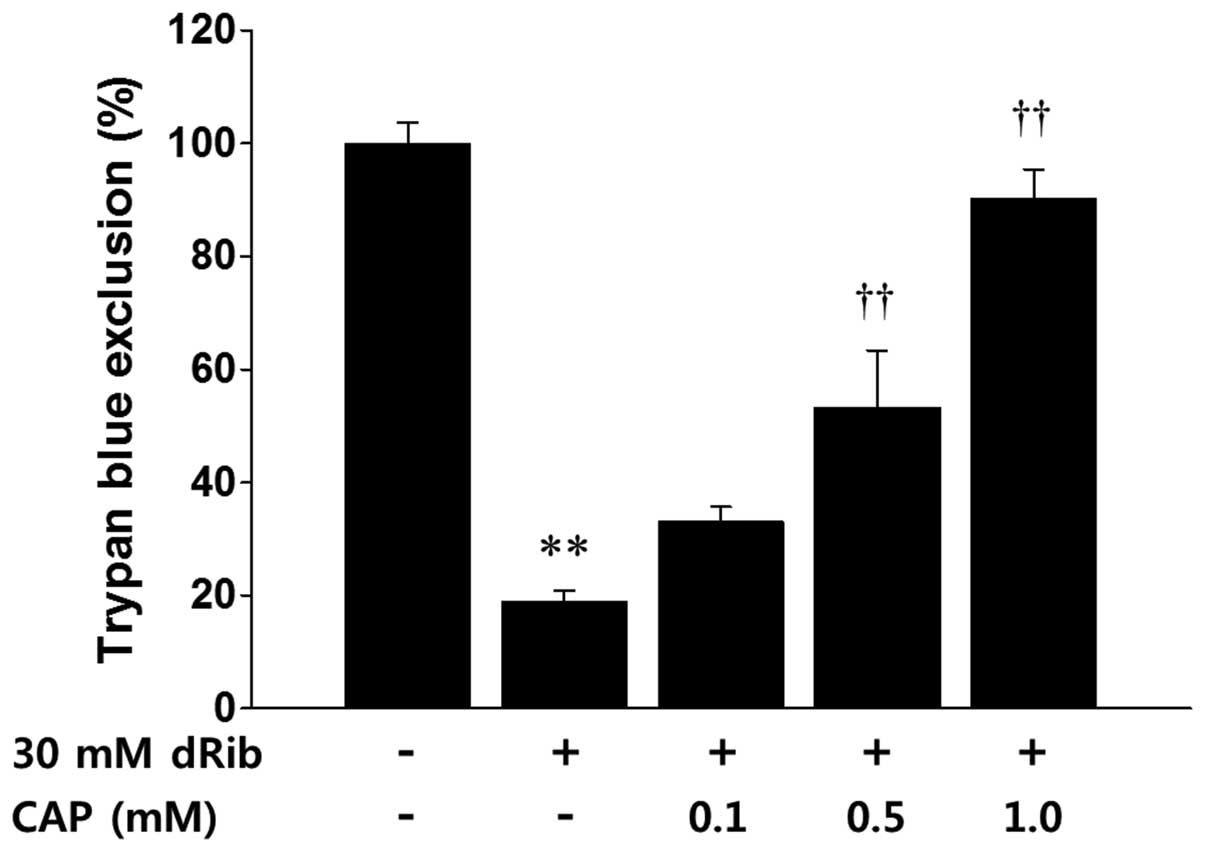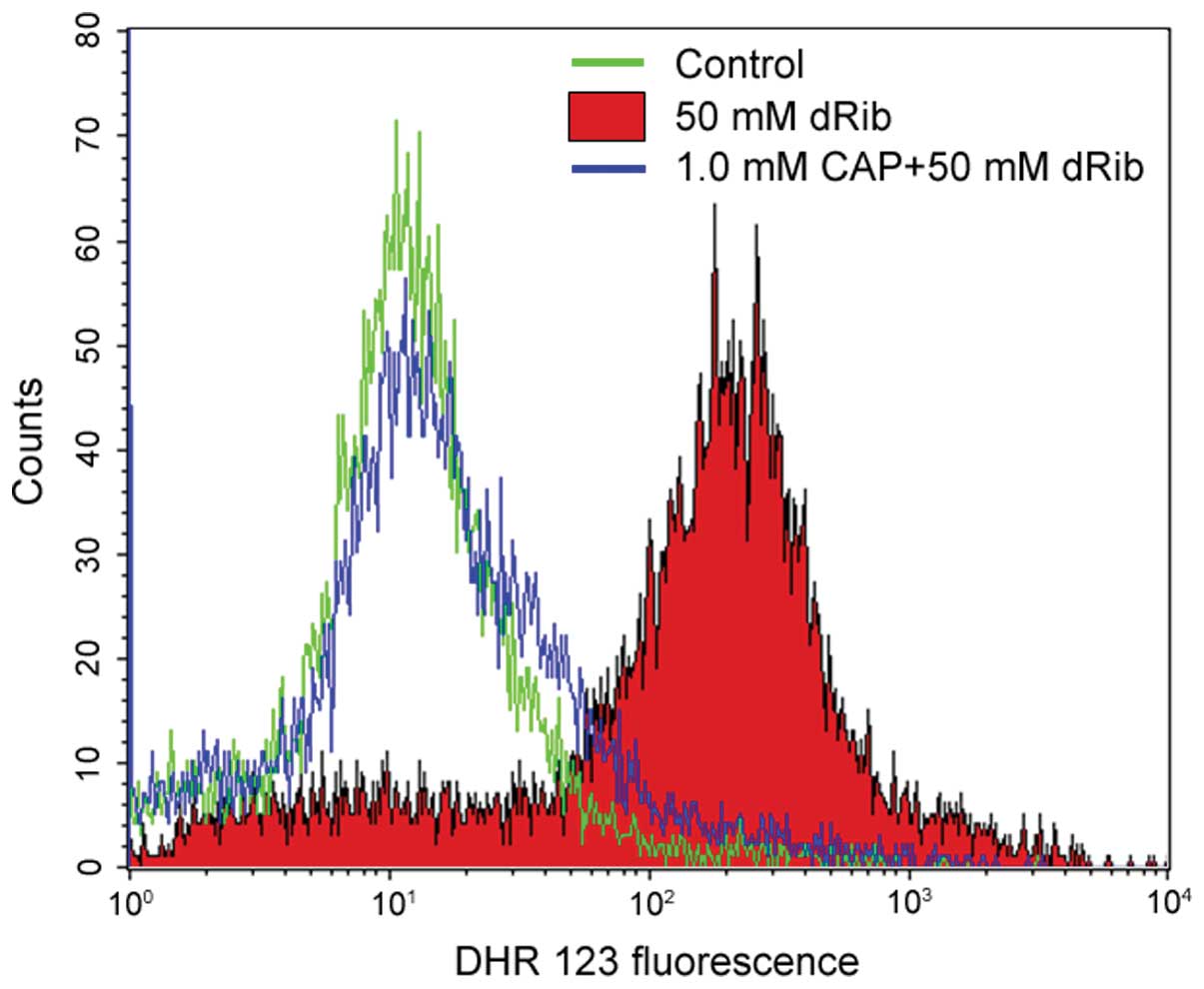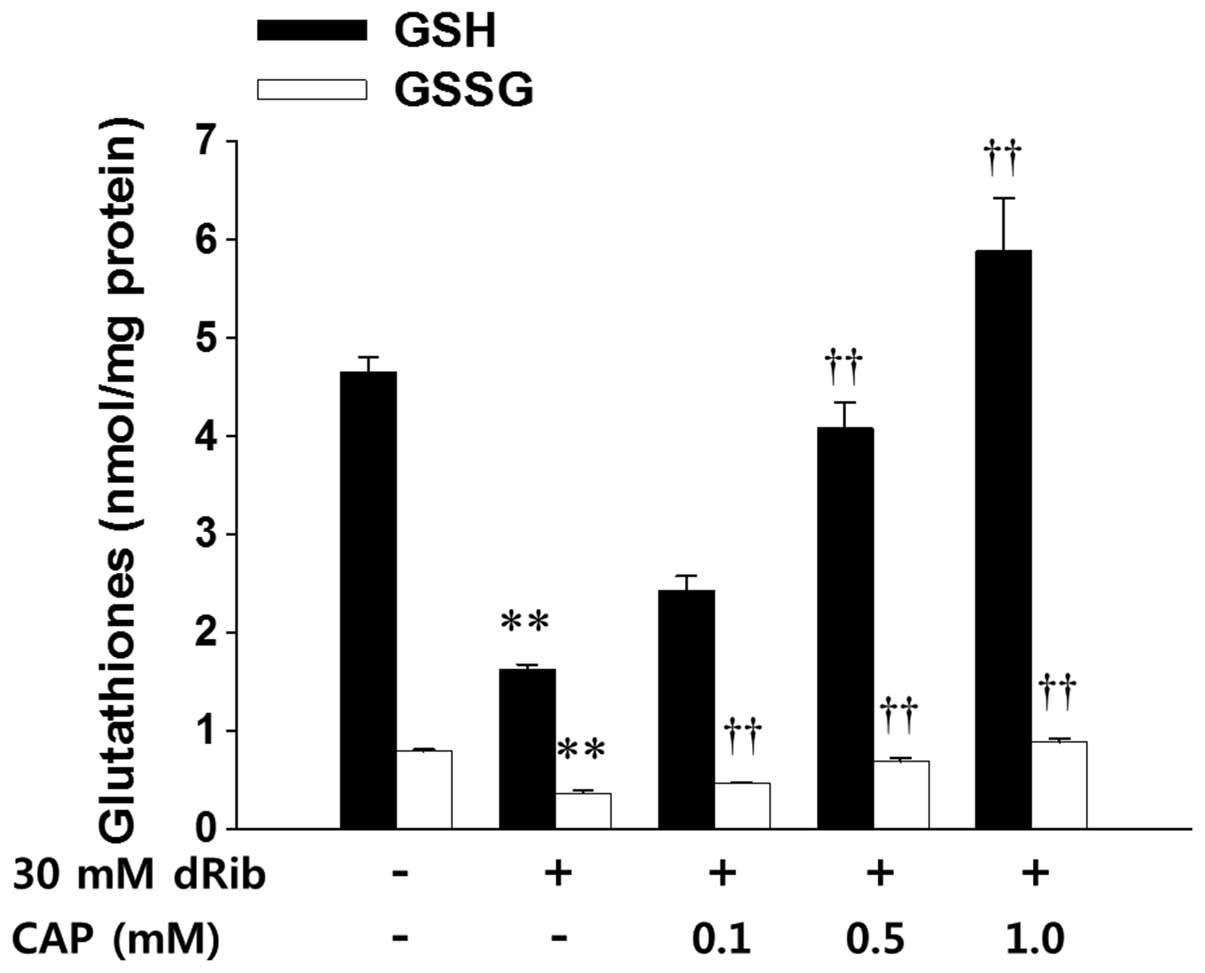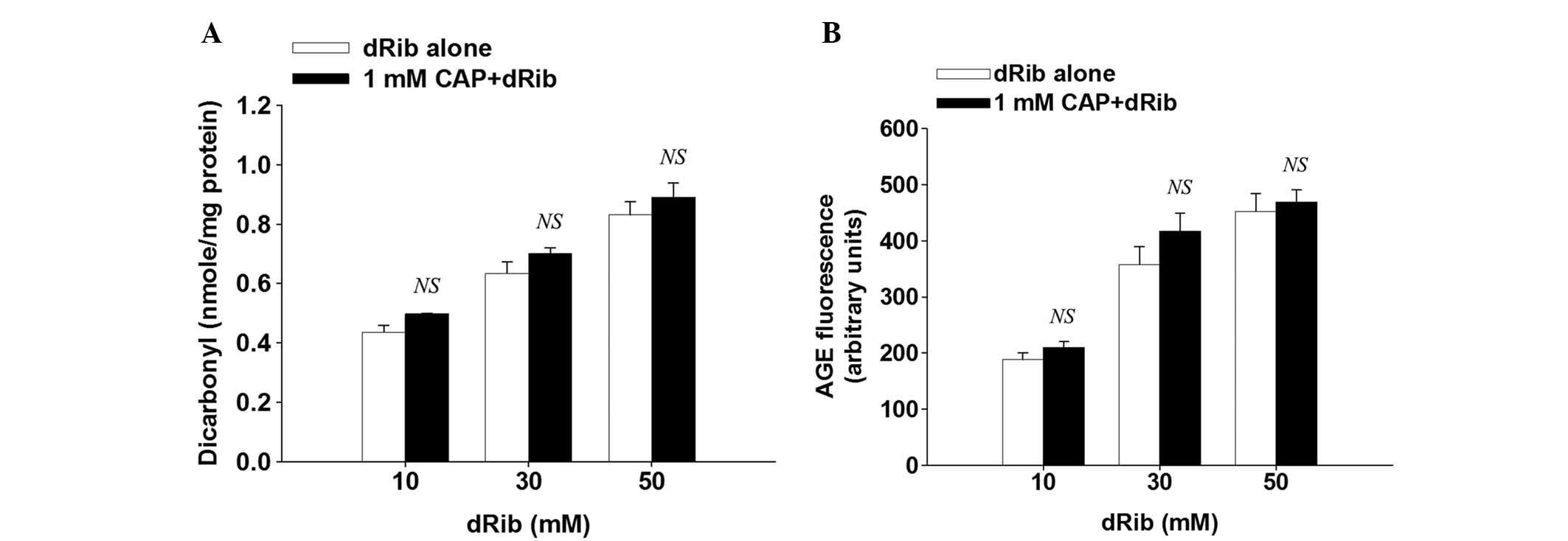Intracellular glutathione production, but not protein glycation, underlies the protective effects of captopril against 2‑deoxy‑D‑ribose‑induced β‑cell damage
- Authors:
- Gwanpyo Koh
- Eun‑Jin Yang
- Ji Young Kim
- Jonghoon Hyun
- Soyeon Yoo
- Sang Ah Lee
View Affiliations
Affiliations: Department of Internal Medicine, Jeju National University School of Medicine, Jeju‑si, Jeju 690‑767, Republic of Korea, Department of Internal Medicine, Jeju National University Hospital, Jeju‑si, Jeju 690‑767, Republic of Korea
- Published online on: July 6, 2015 https://doi.org/10.3892/mmr.2015.4047
-
Pages:
5314-5320
Metrics: Total
Views: 0 (Spandidos Publications: | PMC Statistics: )
Metrics: Total PDF Downloads: 0 (Spandidos Publications: | PMC Statistics: )
This article is mentioned in:
Abstract
Our previous study reported that both oxidative stress and protein glycation were the principal mechanisms underlying 2‑deoxy‑D‑ribose (dRib)‑induced pancreatic β‑cell damage. The aim of the present study was to investigate the effects of captopril on dRib‑induced damage in pancreatic β‑cells, as well as to determine the mechanisms underlying these effects. Treatment with dRib increased the levels of cytotoxicity, apoptosis, and intracellular reactive oxygen species in Syrian hamster insulinoma HIT‑T15 cells; however, pretreatment with captopril significantly inhibited the effects of dRib. The intracellular levels of reduced and oxidized glutathione were depleted following treatment with dRib; however, these levels were restored following HIT‑T15 cell treatment with captopril. In rat islets, dRib stimulation suppressed the mRNA expression levels of insulin, and pancreatic and duodenal homeobox 1, as well as insulin content; however, these effects were dose‑dependently reversed by treatment with captopril. Treatment with buthionine sulfoximine, an inhibitor of intracellular glutathione biosynthesis, inhibited the protective effects of captopril on dRib‑mediated glutathione depletion and cytotoxicity in HIT‑T15 cells. Following incubation with albumin, dRib increased the formation of dicarbonyl and advanced glycation end products. Treatment with captopril did not inhibit the dRib‑induced increase in production of dicarbonyl and advanced glycation end products. In conclusion, treatment with captopril reversed dRib‑induced oxidative damage and suppression of insulin expression in β‑cells. The mechanism underlying the protective effects of captopril may involve increased intracellular glutathione production, rather than protein glycation.
View Figures |
Figure 1
|
 |
Figure 2
|
 |
Figure 3
|
 |
Figure 4
|
 |
Figure 5
|
 |
Figure 6
|
 |
Figure 7
|
View References
|
1
|
Monnier VM: Nonenzymatic glycosylation,
the Maillard reaction and the aging process. J Gerontol.
45:B105–B111. 1990. View Article : Google Scholar : PubMed/NCBI
|
|
2
|
Koh G, Lee DH and Woo JT: 2-Deoxy-D-ribose
induces cellular damage by increasing oxidative stress and protein
glycation in a pancreatic beta-cell line. Metabolism. 59:325–332.
2010. View Article : Google Scholar
|
|
3
|
Robertson RP, Harmon J, Tran PO, Tanaka Y
and Takahashi H: Glucose toxicity in beta-cells: Type 2 diabetes,
good radicals gone bad, and the glutathione connection. Diabetes.
52:581–587. 2003. View Article : Google Scholar : PubMed/NCBI
|
|
4
|
Brownlee M: Biochemistry and molecular
cell biology of diabetic complications. Nature. 414:813–820. 2001.
View Article : Google Scholar : PubMed/NCBI
|
|
5
|
Scheen AJ: Prevention of type 2 diabetes
mellitus through inhibition of the Renin-Angiotensin system. Drugs.
64:2537–2565. 2004. View Article : Google Scholar : PubMed/NCBI
|
|
6
|
DeFronzo RA: Lilly lecture 1987. The
triumvirate: Beta-cell, muscle, liver A collusion responsible for
NIDDM. Diabetes. 37:667–687. 1988. View Article : Google Scholar : PubMed/NCBI
|
|
7
|
Mak IT, Freedman AM, Dickens BF and
Weglicki WB: Protective effects of sulfhydryl-containing
angiotensin converting enzyme inhibitors against free radical
injury in endothelial cells. Biochem Pharmacol. 40:2169–2175. 1990.
View Article : Google Scholar : PubMed/NCBI
|
|
8
|
Hayek T, Attias J, Smith J, Breslow JL and
Keidar S: Antiatherosclerotic and antioxidative effects of
captopril in apolipoprotein E-deficient mice. J Cardiovasc
Pharmacol. 31:540–544. 1998. View Article : Google Scholar : PubMed/NCBI
|
|
9
|
Andreoli SP: Captopril scavenges hydrogen
peroxide and reduces, but does not eliminate, oxidant-induced cell
injury. Am J Physiol. 264:F120–F127. 1993.PubMed/NCBI
|
|
10
|
Lacy PE and Kostianovsky M: Method for the
isolation of intact islets of Langerhans from the rat pancreas.
Diabetes. 16:35–39. 1967. View Article : Google Scholar : PubMed/NCBI
|
|
11
|
Mitchel RE and Birnboim HC: The use of
Girard-T reagent in a rapid and sensitive methods for measuring
glyoxal and certain other alpha-dicarbonyl compounds. Anal Biochem.
81:47–56. 1977. View Article : Google Scholar : PubMed/NCBI
|
|
12
|
Degenhardt TP, Thorpe SR and Baynes JW:
Chemical modification of proteins by methylglyoxal. Cell Mol Biol
(Noisy-le-grand). 44:1139–1145. 1998.
|
|
13
|
Bagchi D, Prasad R and Das DK: Direct
scavenging of free radicals by captopril, an angiotensin converting
enzyme inhibitor. Biochem Biophys Res Commun. 158:52–57. 1989.
View Article : Google Scholar : PubMed/NCBI
|
|
14
|
Chen SX, Song T, Zhou SH, Liu YH, Wu SJ
and Liu LY: Protective effects of ACE inhibitors on vascular
endothelial dysfunction induced by exogenous advanced oxidation
protein products in rats. Eur J Pharmacol. 584:368–375. 2008.
View Article : Google Scholar : PubMed/NCBI
|
|
15
|
Harmon JS, Gleason CE, Tanaka Y, Oseid EA,
Hunter-Berger KK and Robertson RP: In vivo prevention of
hyperglycemia also prevents glucotoxic effects on PDX-1 and insulin
gene expression. Diabetes. 48:1995–2000. 1999. View Article : Google Scholar : PubMed/NCBI
|
|
16
|
Robertson RP: Chronic oxidative stress as
a central mechanism for glucose toxicity in pancreatic islet beta
cells in diabetes. J Biol Chem. 279:42351–42354. 2004. View Article : Google Scholar : PubMed/NCBI
|
|
17
|
Koh G, Kim MK, Yang EJ and Lee DH:
Gliclazide does not fully prevent 2-deoxy-D-ribose-induced
oxidative damage because it does not restore glutathione content in
a pancreatic β-cell line. Oxid Med Cell Longev. 2012:3906782012.
View Article : Google Scholar
|
















